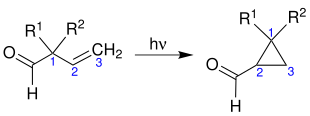Di-π-methane rearrangement
The di-π-methane rearrangement is a reaction in organic chemistry that was first described by HE Zimmerman and GL Grunewald. For this reason, the reaction is also known as the "Zimmerman rearrangement". The di-π-methane rearrangement is a photochemical reaction to obtain vinylcyclopropane from a 1,4- diene .
Reaction mechanism
In the first step of the reaction, 1,4-diene 1 is converted into a diradical 2 through photochemical action . This is followed by the break of a CC single bond and a diradical 3 is formed again . However, this can only form if the 1,4-diene 1 is substituted in the 3rd position in order to stabilize the diradical 3 . In the last step, a new CC single bond is formed and the desired vinylcyclopropane 4 is formed .
variants
Different variants of this rearrangement reaction are known:
- Oxa-di-π-methane rearrangement
- Aza-di-π-methane rearrangement
- Arylvinyl type di-π-methane rearrangement
Individual evidence
- ↑ Zimmerman, HE; Grunewald, GL; J. Am. Chem. Soc. 1966 , 88, 183.
- ↑ a b T. Laue and A. Plagens: Name and keyword reactions of organic chemistry , 5th edition, Teubner Study Books Chemistry, 2006, p. 105; ISBN 3-8351-0091-2 .
- ↑ Zimmerman, HE; Armesto, D .; Chem. Rev. 1996 , 96, 3065.
- ^ Z. Wang: Comprehensive Organic Name Reactions and Reagents , Volume 1, Wiley Verlag, 2009, p. 910, ISBN 978-0-471-70450-8 , (3-Volume Set).




